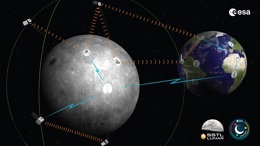Ever since the discovery of water inside the permanently shadowed creater of the Moon has revived the desire to return to Earth’s own natural satellite.
KSAT network and experience already makes it possible to support lunar missions. The ground stations in Svalbard, Norway and in Inuvik, Canada, with their 13m-class antennas, are already in use for that purpose, complimented by partner antennas, and KSAT LEOP stations. Going forward, KSAT's 13m antennas and KSAT's partner stations will not be enough to satisfy the missions' recruitement and the growing demand for lunar comms. To satisfy this demand, KSAT will invest in dedicated network of 20m-class antennas.
The future of KSAT's lunar network
The objective of NASA's Artemis program is to return astronauts to the lunar surface - this time to stay. Artemis 1, due to launch in some weeks’ time, is an important milestone in the program. KSAT is playing a part in the NASA Artemis1 mission, by providing space-to-ground communication to LunIR, a spacecraft onboard Artemis 1, that will perform a fly-by of the Moon and collect important data about its surface, and by tracking the Orion capsule to help determine its location and distance to Earth. In addition, KSAT is working together with small- and large-scale lunar missions that will take place in the years to come. Gaining experience about the wide array of missions is essential.

"The requirements from future missions demanding 24/7 coverage of the Moon with the highest reliability and support of big data transfers with use of specific frequencies, motivated KSAT to undertake the challenge in leading the way in the commercial lunar network ground stations development by building dedicated 20m-class antennas." Rolf Skatteboe, President and CEO of KSAT (image).
New challenges
According to Bryce and NSR reports as well as KSAT’s own market research, 100 to 140 lunar missions will be launched in the next ten years. This includes a wide range of mission profiles, from CubeSats, through rovers, to crewed missions.
The presence of water on the South Pole makes the region a priority landing site. The limited direct-to-Earth communication possibilities to the poles requires the use of lunar relay satellites, which we will also support and integrate in our network.
The new standard
In 2022, NASA released its requirements for Lunar Exploration Ground Sites (LEGS) KSAT's lunar network will be compliant with LEGS' requirements. KSAT considers 20m-antennas to be "the sweet spot" for lunar missions.
KSAT's lunar antennas will provide tri-band support (S, X, Ka) in both transit and receive, while meeting the requirements of top 3 planned lunar relay constellations. In addition, the optimal placement of KSAT lunar antennas will ensure continuous communication with the Moon.
"It will also mean that the sole focus and purpose of the new network will be the lunar missions, enabling KSAT to provide the highest possible level of support - through a single point of integration" Skatteboe adds.



